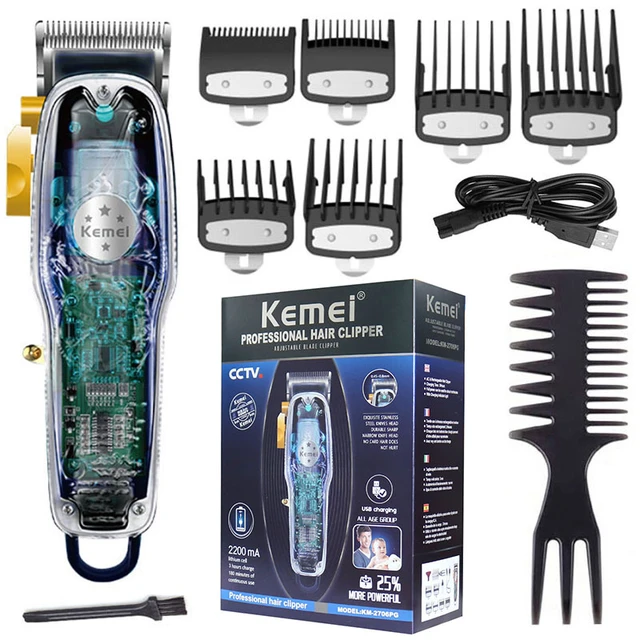Introduction:
Using hair clippers solely on wet hair is not a common practice, as it presents several challenges and limitations. While clippers can effectively cut wet hair to some extent, it is generally recommended to use them on dry or slightly damp hair for optimal results. Understanding the reasons behind this recommendation can help you achieve better haircuts and maintain the longevity of your clippers. In this guide, we will explore the limitations and considerations of using clippers exclusively on wet hair, including issues with moisture, blade performance, hygiene, and overall haircut quality. By understanding these factors, you can make informed decisions about the appropriate use of clippers on wet and dry hair.

Can a clipper be used only on wet hair?
The Challenges of Using Clippers on Wet Hair:
Using clippers exclusively on wet hair presents several challenges that can affect both the quality of the haircut and the performance of the clippers. Consider the following limitations:
a. Uneven Cutting: Wet hair tends to stick together, making it challenging to achieve even and precise cuts. The clippers may struggle to gather and cut the hair uniformly, resulting in inconsistent lengths and potential gaps in the haircut.
b. Difficulty Assessing Length: Wet hair can shrink as it dries, making it challenging to accurately assess the final length of the haircut. This can lead to haircuts that appear shorter than intended, potentially causing dissatisfaction for the client.
c. Reduced Blade Performance: Wet hair can cause the clippers’ blades to become clogged with moisture, hair clippings, and possibly even product residue. This buildup can affect the performance of the clippers, causing them to pull or snag the hair rather than cutting smoothly.
d. Hygiene Concerns: Working with wet hair can lead to moisture accumulating in the clippers, creating an environment for bacteria or mold to grow. This can compromise the hygiene and cleanliness of the clippers, potentially leading to unpleasant odors or even skin infections.
e. Potential Damage to Clippers: Continuous exposure to moisture can have detrimental effects on the clippers’ blades and motor. Moisture can accelerate rusting, corrosion, and overall wear and tear, reducing the lifespan and performance of the clippers.
The Benefits of Using Clippers on Dry or Slightly Damp Hair:
Using clippers on dry or slightly damp hair is generally recommended for several reasons. Consider the following benefits:
a. Better Control and Precision: Dry or slightly damp hair is easier to handle and control, allowing for more precise cutting and shaping. Clippers can glide smoothly through the hair, resulting in cleaner lines and a more consistent haircut.
b. Accurate Length Assessment: Cutting dry or slightly damp hair provides a more accurate assessment of the final length, as there is no moisture-induced shrinkage. This is particularly important when maintaining specific hair lengths or achieving precise results.
c. Improved Blade Performance: Working with dry or slightly damp hair reduces the likelihood of moisture and hair clippings accumulating on the blades. This helps maintain the clippers’ performance, ensuring smooth cutting without pulling or snagging.
d. Hygiene and Maintenance: Cutting dry or slightly damp hair reduces the risk of moisture-related issues, such as bacterial growth or unpleasant odors. It also simplifies the maintenance and cleaning process of the clippers, ensuring they remain in optimal condition.
The Role of Dampness in Haircutting:
While using clippers on wet hair is generally discouraged, slightly damp hair can be more manageable for cutting. Consider the following scenarios:
a. Tapering or Fading Techniques: Some haircuts, such as fades or tapers, may require the hair to be slightly damp to achieve a smooth transition between different lengths. Dampening the hair can help the clippers glide through the hair more smoothly, ensuring an even and well-blended result.
b. Thicker or Coarser Hair Types: For individuals with thicker or coarser hair types, dampening the hair slightly can make it more pliable and easier to cut. This can help with achieving cleaner lines and reducing resistance during the cutting process.
Adjusting Techniques for Wet Hair:
In situations where cutting wet hair is necessary, it is important to adjust your technique to mitigate some of the challenges mentioned earlier. Consider the following tips:
a. Use Smaller Sections: Divide the wet hair into smaller sections to ensure better control and prevent clumping. This allows the clippers to cut through the hair more evenly and reduces the risk of uneven cutting.
b. Take Your Time: Cutting wet hair may require more time and attention to detail. Take your time to ensure each section is cut evenly and consistently, making adjustments as necessary.
c. Monitor Blade Buildup: Regularly check the blades for moisture, hair clippings, or product residue buildup. Wipe the blades clean as needed to prevent clogging and maintain optimal cutting performance.
d. Dry the Clippers Thoroughly: After using clippers on wet hair, ensure they are thoroughly dried to minimize the risk of corrosion or damage to the blades and motor.
Conclusion:
While clippers can be used on wet hair to some extent, it is generally recommended to use them on dry or slightly damp hair for optimal results. Wet hair presents challenges such as uneven cutting, difficulty assessing length, reduced blade performance, hygiene concerns, and potential damage to the clippers. Dry or slightly damp hair offers better control, precision, and accuracy during the cutting process. It improves blade performance, promotes hygiene, and aids in accurate length assessment. Adjusting techniques for wet hair and considering dampness in certain haircut styles or hair types can help mitigate some of the challenges. By understanding these considerations, you can make informed decisions about the appropriate use of clippers on wet and dry hair, resulting in clean and professional haircuts while maintaining the longevity of your clippers.
